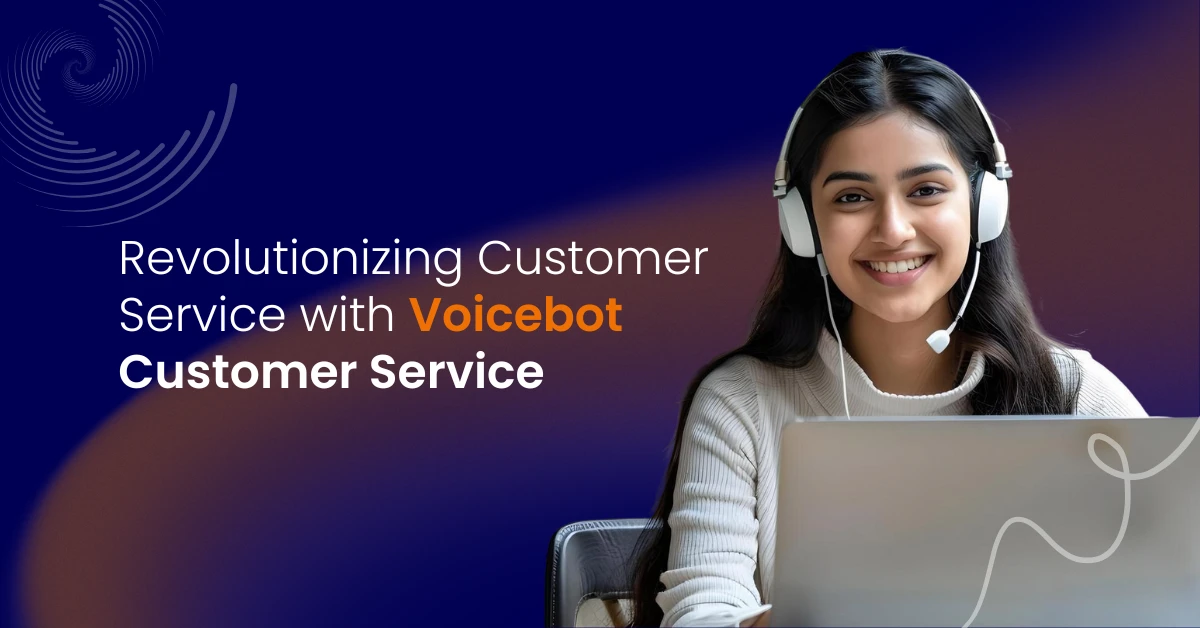Revolutionizing Customer Service with Voicebot Customer Service

12 min read
Table of Contents
Upgrading customer service with voicebots is now becoming a necessity for businesses. Conversational interfaces are poised to take over an increasing number of client service interactions in the near future.
Voicebots can help businesses reduce service costs and deliver significant savings in operational expenses by automating routine tasks.
- It can lower per-call costs compared to human agents
- Reduce the number of human agents required
- Provide a more personalized experience
- Makes a frictionless experience for customers
Voicebots reduce customer wait times. It simplifies customer interactions by making conversations more efficient for both customers and businesses. Customers who prefer to interact with AI voice assistants will benefit from natural interactions.
These modern voicebots are designed to interpret and respond to human speech. So, these voicebots make conversations flow uninterruptedly. This technology might even allow companies to offer 24-hour service without any humans on staff.
Upgrade your customer service with advanced voicebot technology. Explore Vitel Global’s advanced business phone systems and VoIP services to get started. Request a free demo today!
Introduction
Voicebots are at an all-time high as they change the way customer service is handled. The power of voice can be utilized in a number of innovative ways, such as giving analysis.
Recent technology advances, especially in voice AI, have enabled voicebots to deliver more sophisticated and effective customer service solutions. This article will explore some of these revolutionary uses and explain why voicebot technology is crucial to the future of service today.
With voicebots becoming more and more popular, you may be wondering just how this technology has changed the way customer service works today. And where it’s going next! In this article, let’s see important trends that have helped propel this dramatic shift in industry practices: automation, messaging, artificial intelligence, and virtual agents.
Considering an upgrade to your current phone system? Vitel Global offers scalable cloud communication solutions designed to integrate seamlessly with voicebot technology. Contact our sales team to learn more.
Automation of Customer Interactions
To begin with, we must acknowledge the significant impact that automation has had on customer service. By automating tasks and repetitive tasks, businesses can efficiently handle repetitive tasks and repetitive queries, reducing operational costs and improving overall efficiency.
With new technology replacing employees who used to handle customer requests, businesses are able to save millions. These new technologies also have built-in artificial intelligence that provides-
- immediate responses
- consistent support for customer inquiries
- important features such as voice recognition
- natural language processing (NLP).
Modern voicebots use natural language understanding to interpret human language. This allows for more accurate and natural interactions. This makes calling a business hassle-free than ever. Customers are able to quickly and easily reach a real person without having to wait through long automated menus or listen to robotic voice messages.
Discover how Vitel Global’s VoIP services can help automate your customer interactions and reduce operational costs. Schedule your free consultation now.
Messaging
For companies that want to take their customer service to the next level, they must take a look at some of the new messaging features. These new technologies allow better integration with social media with other platforms such as email.
Voicebots can operate across multiple languages and provide multilingual support. This makes it accessible to a diverse customer base. This is much easier and more convenient for customers with all of their social media profiles on the same platform. They just need to click a button to send an email or message.
Customers can now continue customer conversations with a business using any platform with this new technology. They can communicate using any device they choose, including different voice channels, without having to call or come into the business itself.
Enhance your customer engagement with Vitel Global’s cloud communication solutions that support seamless messaging across channels. Request a demo to see it in action.
Artificial Intelligence
AI ( artificial intelligence ) has played a major role in the advancements in voicebot technology. It’s important to understand that AI isn’t just about robots with artificial intelligence.
This is about how humans and computers interact and work together. As technology continues to evolve, more companies are using AI to allow customers to respond directly.
It is called natural language processing. With NLP, intelligent machines can process data, giving them the ability to recognize and respond much as a human would by interpreting user requests and performing tasks such as answering questions or processing transactions.
Voicebots analyze and improve conversational accuracy using-
- natural language processing ( NLP )
- intent recognition
These systems undergo continuous improvement by learning from user requests and interactions. This improves their performance over time. Artificial Intelligence has also been used by some companies in the form of voice recognition.
Use AI-powered voicebots integrated with Vitel Global’s phone systems to deliver smarter, more personalized customer service. Contact sales to upgrade your system today.
Virtual Agent
The virtual agent is a type of chatbot that is typically used for customer service purposes. As a form of automated systems, virtual agents are designed to efficiently manage routine customer service tasks such as booking, inquiries, and order tracking.
Virtual agents cannot completely replace human interaction, but they can handle repetitive requests and messages in an efficient and quick manner.
What is virtual voicemail?
This technology is a great way to provide customer service over social media and to new customers who may otherwise avoid interacting with a company’s human staff.
While there are many different types of voicebots, each one is built to meet the unique needs of its customers. Integrating voicebots with existing systems and databases is crucial to ensure seamless operation and functionality within your current technological environment.
Whether it’s a simple bot that can help you find your way around town or a complex system that can be used as part of an elaborate automated marketing campaign, voicebots have the potential to revolutionize your business in immeasurable ways.
Explore how Vitel Global’s cloud communication platform can support your virtual agent and voicebot integrations. Request a free demo today!
What is a Voicebot?
A voicebot is a computer-generated, text-to-speech program that is designed to appear as a human. This program creates audible words by using a combination of text, stored audio, and sounds. The most popular types of voicebots are used to respond to simple commands.
Voice interactions with these bots are designed to be natural and efficient, allowing users to communicate using spoken language. All you have to do is message the bot by typing in your request or question, and the bot will respond with an answer or command.
It is important for voicebots to maintain conversation flow and avoid losing context during interactions, as this ensures a smooth and satisfying user experience.
AI Voicebot System with Natural Language Processing
The voicebot is the artificial, computer-operated voice used by the virtual assistant or agent. Although there are a few different forms of voicebots, they all have common traits and features that differentiate them from other agents or assistants that may be used prior to or after the creation of an AI voicebot system.
It can take many forms; they are generally classified into three types. A first-generation AI voicebot is a system that uses a computer program to generate an animated or synthesized voice to respond to questions.
A second-generation AI voicebot system uses a computer program, but whether the system is animated or not, it is able to understand and recognize words spoken into the microphone and can answer questions in ways that resemble human responses.
Modern AI voicebot systems can also be integrated with a company’s phone system to handle routine customer inquiries more efficiently, improving response times and enhancing the user experience within existing phone support channels.
Finally, third-generation AI voicebots use natural speech recognition technology that allows artificial intelligence to create a response based on algorithms and sound analysis of conversation content. The third generation is also known as cognitive AI voicebots.
Voicebot Use Cases
One of the most well-known uses of voicebots is in the customer service sectors, such as banking and retail. Voicebots are changing contact centers by efficiently managing high call volumes, especially during peak times or promotional events. This helps in reducing operational challenges and improving customer satisfaction.
Voicebots improve operational efficiency by handling a high volume of calls simultaneously. They help in maintaining service quality even during busy hours. Using a voicebot agent in service can offer a more personalized and engaging experience for customers. This improved efficiency and customer experience can result in increased customer retention.
An additional emerging use case is the handling of outbound calls by voicebots. Traditionally, human agents manage the outbound calls for appointment reminders, payment collections, and customer surveys. This can be effectively automated by voicebot technology.
Voicebots-
- reduces the operational costs associated with outbound call campaigns
- ensures consistent communication
- allows human agents to focus on more complex interactions
By automating outbound calls, businesses can increase outreach efficiency, improve customer engagement, and maintain a proactive approach to customer service.
See how Vitel Global’s VoIP and cloud communication solutions can support your voicebot-powered outbound campaigns. Request a free demo today!
Customer Service Trends
- Customer service trends have seen significant shifts over the last few years, including an increase in digital interactions, requests for more self-service options, and consumers who are much less willing to talk on the phone with companies.
- Companies are now turning to voicebots as one way to interact with customers. Call centers are transitioning to automated voicebot solutions, as businesses want to improve efficiency and customer satisfaction.
- Voice Calling is being used in client service as it offers the potential for more personal service by removing the barrier of having to speak with a representative.
- Voice Bots are used in call centers to reduce staff numbers and provide enhanced customer interaction. But human intervention is still needed for handling complex or sensitive customer issues that voicebots cannot resolve, resulting in a smooth and satisfactory customer experience.
Revolutionizing client service with voice bots is a transformative approach to enhancing customer support and engagement. It is also known as voice assistants or virtual agents. AI-powered systems that can interact with customers using natural language processing and voice recognition technology.
Benefits of Having Automated Chatbots
They offer several benefits for businesses looking to improve their service operations:
1. 24/7 Availability
It can provide customer service support 24/7, allowing organizations to significantly reduce costs associated with hiring support personnel.
2. Improved Experience
Since it uses natural language processing and real-time speech-to-text capabilities, it can interact with customers in a more natural way. Moreover, the combination of AI and automation will ensure that interactions are fast and personalized. This leads to improved experiences for both customers and businesses operating in competitive industries.
3. Cost Efficiency and Reduced Operational Costs
Voicebot systems can be deployed in place of human interaction with customers. Reduces costs for business owners. It is also more efficient than other call center technologies. Like live chat applications or voicemail.
It can be deployed in place of human interaction with customers, which reduces costs for business owners. It is more efficient than other call center technologies, such as live chat applications or voicemail.
4. Increased Engagement
It will be able to understand natural language and respond appropriately. Businesses will see increased response rates from customers. This provides businesses with a significant competitive advantage as they begin to automate their service operations.
5. Scalability
Voicebot systems can be easily scaled, allowing businesses to quickly and efficiently adjust their operations. With the response to changing business needs.
It can be easily scaled, allowing businesses to quickly and efficiently adjust their operations in response to changing business needs.
6. Faster Learning
By using voice technology, enterprises can provide the ultimate learning environment for new employees. This provides companies with a training model that is highly efficient and cost-effective.
It has already been implemented in a number of industries ranging from healthcare to retail.
Healthcare
Voicebots have been successfully deployed in a number of healthcare contexts. It includes a pharmacy that has been using them as direct-to-consumer touchpoints through Messenger.
Successfully deployed in a number of healthcare contexts. It includes CVS Pharmacy, which has been using them as direct-to-consumer touch points through Facebook Messenger.
Handling Complex Customer Queries
Handling complex customer queries is one of the most demanding aspects of customer service, often requiring a nuanced understanding of customer needs and the ability to deliver tailored solutions. Modern voice bots, powered by advanced natural language processing (NLP) and machine learning, are now equipped to interpret the intent behind customer inquiries, even when those requests are multifaceted or ambiguous.
By leveraging these technologies, voice bots can engage in human-like conversations, ask clarifying questions, and provide relevant information or solutions in real time.
However, not every situation can be resolved by automation alone. When a voice bot encounters a particularly intricate issue, it can seamlessly escalate the conversation to a human agent, ensuring that customers receive the empathetic and personalized support they need.
This collaboration between voice bots and human agents not only streamlines customer interactions but also enhances the overall customer experience. By efficiently handling routine queries and intelligently routing complex cases, businesses can achieve improved customer satisfaction and foster greater customer loyalty.
Voicebot Implementation in Call Centers
Integrating voice bots into call centers is transforming the way organizations manage customer interactions and operational efficiency. Voice bots can automate a wide range of routine tasks, such as answering frequently asked questions, checking account balances, and assisting with simple transactions.
This automation allows human agents to dedicate more time to high-value tasks that require critical thinking and empathy, ultimately boosting agent productivity and job satisfaction.
The deployment of voice bots in call centers also leads to significant reductions in wait times and helps improve first-call resolution rates, both of which are key drivers of overall customer satisfaction.
Voicebots improve first-call resolution rates by providing quick, accurate responses based on customer data, ensuring that customer issues are resolved efficiently.
For a successful implementation, it’s essential to connect voice bots with existing contact center infrastructure, including CRM systems and phone systems, to ensure seamless communication and data sharing.
Ongoing training and regular updates are crucial to keep voice bots aligned with evolving customer needs and to maintain a high standard of service quality. By embracing voice bot solutions, call centers can deliver a superior customer experience while optimizing operational costs.
Customer Data and Voicebots
Customer data is at the heart of delivering personalized and effective customer experiences with voice bots. By integrating voice bots with CRM systems and other data sources, businesses can access valuable insights about customer preferences, past interactions, and purchase history.
This enables voice bots to provide personalized responses and recommendations, making each customer interaction more relevant and engaging.
In addition to enhancing the customer experience, voice bots can also collect new data during conversations, such as feedback, preferences, and pain points. This information can be used to refine service offerings and inform strategic business decisions.
It is essential, however, to handle all customer data securely and in compliance with regulations like GDPR, ensuring customer trust and data privacy. When managed responsibly, the synergy between customer data and voice bots empowers businesses to deliver tailored support and build lasting customer relationships.
Securely manage your customer data and elevate personalization with Vitel Global’s integrated VoIP and CRM solutions. Contact us today for more information.
Future of Voicebots in Customer Service
The future of voice bots in customer service is bright, driven by rapid advancements in natural language processing (NLP), machine learning, and artificial intelligence. As these technologies continue to evolve, voice bots are becoming increasingly adept at understanding and responding to complex customer queries in natural language, making interactions feel more intuitive and human-like.
Looking ahead, the integration of voice bots with smart devices and IoT platforms will open up new possibilities for seamless communication across multiple channels. Industries such as healthcare, finance, and retail are already exploring innovative ways to leverage voice bots for enhanced customer support and engagement.
Implementing voicebot technology can lead to annual savings of approximately $438,000 for a contact center managing 1,000 daily voice interactions, showcasing the financial benefits of adopting this technology.
As adoption grows, businesses can expect to see significant improvements in operational efficiency, cost savings, and the ability to provide highly personalized customer support. The ongoing evolution of voice bot technology promises to redefine the customer journey and set new standards for customer care.
Stay ahead of the curve with Vitel Global’s innovative cloud communication and VoIP services designed for the future of voicebot customer service. Request a demo today!
Measuring Success and Overcoming Challenges
To ensure that voice bot solutions are delivering value, it’s essential to measure their impact using key performance indicators such as customer satisfaction, first-call resolution rates, average handling time, and containment rates. Regularly tracking these metrics helps businesses understand how well their voice bots are meeting customer needs and where improvements can be made.
Challenges such as technical glitches, language barriers, or customer frustration may arise, but these can be addressed through continuous monitoring, user feedback, and iterative improvements. Voicebots consistently provide accurate information, reducing the likelihood of errors compared to human agents, which helps to build trust and reliability in automated systems.
Leveraging analytics allows businesses to identify pain points and optimize the voice bot experience, ensuring that customer interactions remain smooth and effective. By staying proactive and data-driven, organizations can overcome obstacles, enhance customer experience, and maximize the return on their investment in voicebot technology.
Optimize your voicebot performance and maximize ROI with Vitel Global’s expert support and cloud communication solutions. Contact our team to learn how.
Voice Bots are the next step in the evolution of customer service. They are poised to become essential components of nearly every customer interaction. Already, it has begun to change the way that some customers interact with organizations. Including changing where and when they interact with certain companies.
Transform your customer service experience and reduce costs with Voicebots
Discover the Power of Voicebots
Frequently Asked Questions
1. What is voicebot customer service?
Voicebot customer service refers to the use of AI-powered voicebots to handle customer interactions over voice channels. These voicebots use natural language processing (NLP) to understand and respond to customer inquiries, automating routine tasks and providing human-like conversations.
2. How do voicebots improve customer engagement?
Voicebots enhance customer engagement by providing immediate responses, personalized interactions, and 24/7 availability. They can handle multiple languages and complex queries, creating a seamless and satisfying customer experience.
3. What are the benefits of using voicebots in call centers?
Voicebots reduce operational costs by automating repetitive tasks, improve agent productivity by allowing human agents to focus on high-value tasks, decrease wait times, and increase overall customer satisfaction through consistent and accurate responses.
4. How do voicebots differ from traditional IVR systems?
Unlike traditional IVR systems that rely on fixed menu options, voicebots use advanced natural language understanding to engage in conversational interactions. They handle complex queries more effectively and provide personalized responses based on customer data.
5. Can voicebots handle complex customer queries?
Yes, modern voicebots leverage machine learning and NLP to interpret and respond to complex queries. When needed, they can seamlessly escalate difficult issues to human agents to ensure personalized support.
6. How do voicebots integrate with existing contact center systems?
Voicebots can be integrated with CRM systems, phone systems, and other backend platforms via APIs. This integration enables personalized responses, real-time data access, and smooth transitions between automated and human support.
7. Are voicebots available in multiple languages?
Yes, many voicebot solutions support multilingual interactions, allowing businesses to serve a diverse customer base without additional staffing for language-specific support.
8. What metrics should be used to measure voicebot success?
Key metrics include customer satisfaction scores, first-call resolution rates, average handling time, containment rates, escalation rates, and customer retention. Monitoring these helps optimize voicebot performance and customer experience.
9. How do voicebots help reduce operational and service costs?
By automating routine customer interactions and reducing the need for large human support teams, voicebots significantly lower staffing, training, and infrastructure costs, leading to substantial cost savings. The average cost per interaction handled by a voicebot is approximately $0.40, compared to $7-$12 per call for human agents, making them a cost-effective solution for businesses aiming to optimize their customer service operations.
10. What role does artificial intelligence play in voicebot customer service?
Artificial intelligence enables voicebots to understand natural language, learn from interactions, and continuously improve their responses, making conversations more human-like and effective over time.
Published: September 19th, 2023
Subscribe to Our Latest Updates
Get monthly product and feature updates, the latest industry news, and more!






